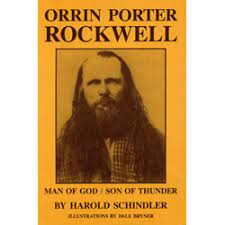Articles/Essays – Volume 16, No. 4
Revised But Unchanged | Harold Schindler, Orrin Porter Rockwell: Man of God, Son of Thunder
Published first in 1966, Harold Schindler’s biography of Porter Rockwell has been widely read and has received well-deserved acclaim for its evidence of careful research, its objectivity, its literary merit, and its re markable illustrations. Now, after the pas sage of seventeen years and five additional printings, the author and the editors of the University of Utah Press have chosen to publish a revised and enlarged edition which includes additional research and more mature perspectives.
According to the author, much of the new material “has been fitted into the foot notes, and while most of it is supplemental, it is there to flesh out the individuals and events of Orrin Porter Rockwell’s world” (p. xiii).
These lengthy footnotes give added evidence of Schindler’s meticulous research but often add to the difficulty of following the narrative. In fact, footnotes in fine print occupy from one half to two-thirds of several pages, reminding one of the writings of Herbert Howe Bancroft and other nineteenth-century writers. Readers might be well advised to ignore the foot notes during the initial reading and, after getting the narrative in mind, return for a more careful evaluation of the validity of the account by a careful examination of the footnotes.
The late Gustive O. Larson reviewed the first edition of the Rockwell biography for DIALOGUE (Winter 1966) and objected primarily to the “over-abundance of irresponsible testimony and sensationalism represented by such names as William Daniels, Bill Hickman, Joseph H. Jackson, Swartzell, Achilles, Beadle, and . . . Kelly and Birney’s ‘Holy murder’ … ” I feel that Larson’s criticism is still valid and see little effort on the part of the author to rectify this tendency.
True, he has identified the oft-quoted “Achilles, the mysterious tale-teller and self-proclaimed purveyor of Rockwell’s confession . . . as Samuel D. Serrine” but admits that he “continues to elude close examination” and “is as much a mystery as his pseudonym” (p. xv).
The extensive use of such sources may reduce the credibility of some of Schindler’s conclusions and leaves the reader wondering about Rockwell’s involvement in the Boggs, Aiken, and King Robinson affairs, not to speak of lesser known crimes such as the drowning of an elderly female gossip in Nauvoo (see lengthy footnote on p. 105). Similarly, sources quoted describing Porter’s involvement with the wife of Amos Davis (pp. 142-43) are Hall’s Abominations of Mormonism Exposed; Ford’s History of Illinois, and the Warsaw Signal. Schindler seems to accept the incident as factual but makes no attempt to give Rockwell’s side of the story nor to account for why this “plural wife” is not mentioned again.
Perhaps the author’s desire to be objective has led him to include questionable sources, but this should not obscure the fact that Hal Schindler has produced a very readable and valuable book. His subject, Orrin Porter Rockwell, emerges from the legendary shadows as a rugged, courageous, warm human being who was in volved in many important events in Mormon and Utah history, and Schindler has included enough historic background for these events to give the reader an interesting interpretation of this history to 1878.
An extensive bibliography, a detailed index, and Dale Bryner’s miniature pen and-ink illustrations coupled with Harold Schindler’s exhaustive research and journalistic writing style make this handsome volume an attractive “must” for anyone interested in Mormon and Utah history.
Orrin Porter Rockwell: Man of God, Son of Thunder by Harold Schindler (Salt Lake City: University of Utah Press, 1983), xvi, 417 pp., $25.00


 Back to full Issue
Back to full Issue

